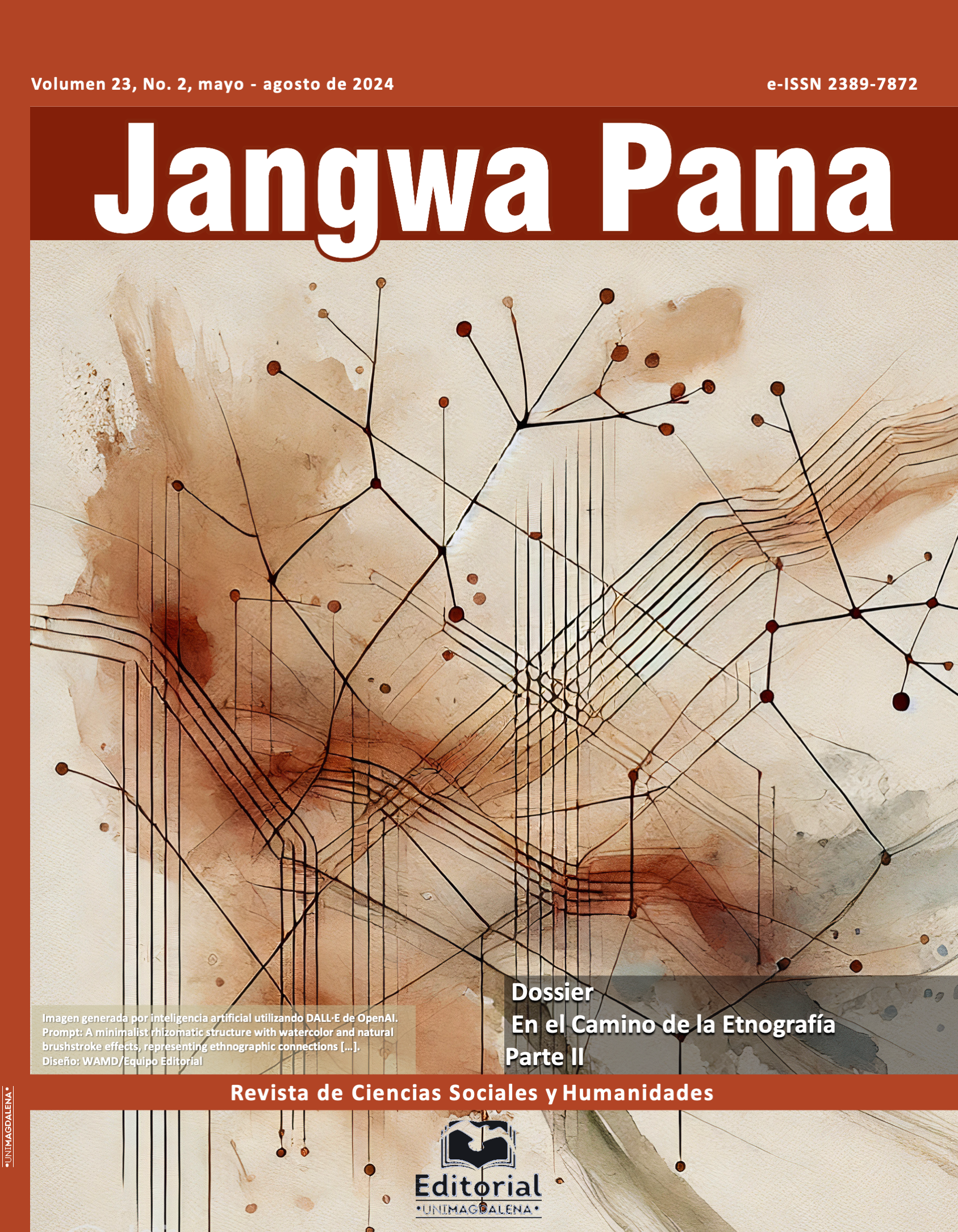Interethnic relations in the Colombian Caribbean. An ethnographic approach to Zenú people
Main Article Content
Abstract
Downloads
Article Details
References
Aguilar, I., y Márquez, E. (2006). El arte del tejido entre los hombres de la etnia Wayuu de la Guajira colombo-venezolana. Fundación Universidad de América. http://hdl.handle.net/20.500.11839/7089
Aroca, A. (2008). Una propuesta metodológica en etnomatemáticas. Revista U.D.C.A Actualidad y Amp; Divulgación Científica, 11(1), 67-76. https://doi.org/10.31910/rudca.v11.n1.2008.603
Aylwin, J. (2002). El acceso de los indígenas a la tierra en los ordenamientos jurídicos de América Latina: un estudio de caso. Serie Desarrollo Productivo y Empresarial CEPAL (Vol. II). Santiago de Chile. https://repositorio.cepal.org/server/api/core/bitstreams/d7e67c06-6a9e-4605-bf1d-1ab6914a2bf5/content
Barth, F. (Ed.). (1969). Ethnic groups and boundaries. Little Brown and Company.
Carneiro da Cunha, M. (2009). Cultura com aspas e outros ensaios. Cosac & Naify.
Carneiro da Cunha, M., & Viveiros de Castro, E. (1985). Vingança e temporalidade: os Tupinambá. Journal de la Société des Américanistes, (71), 191-208. https://www.academia.edu/65945302/Vingan%C3%A7a_e_temporalidade_os_Tupinamba
Castellanos, D. (2013). Locations of Envy. An Ethnography of Aguabuena Potters. [Tesis de Doctorado en Filosofía, University of St Andrews, UK].
Drexler, J. (2002). En los montes sí, aquí no. Cosmología y medicina tradicional de los zenúes. Ediciones Abya-Yala.
Falchetti, A. (2009). El ocaso del Gran Zenú. En Cartagena de Indias en el Siglo XVI. Banco de la República. http://repositorio.banrep.gov.co/handle/20.500.12134/6766 .
Guss, D. (1989). To weave and sing: art, symbol, and narrative in the South American rain forest. University of California Press.
Hartung, M. (2013). “Ser E não ser”, eis a questão: relatórios antropológicos, categorias nativas e Antropologia Revista de Antropologia Vol. 56, No. 2. 323-364. https://www-jstor-org.ezproxy.unal.edu.co/stable/43854899
Larraín, A., y Madrid, P. (2020). Aproximaciones al discurso de lo paisa en Colombia. Revista de Antropología y Sociología: VIRAJES, 22(2), 185-209. http://vip.ucaldas.edu.co/virajes/downloads/Virajes22(2)_10.pdf
Larraín, A., y Uscátegui, C. (2020). Sombreros made in China. Una reflexión sobre la producción artesanal y la propiedad intelectual en el caribe colombiano. Revista Desacatos, (64), 118-131. https://dialnet.unirioja.es/servlet/articulo?codigo=7681828
Latour, B. (2007). Nunca fuimos modernos. Ensayo de Antropología Simétrica. Siglo XXI Editores.
Losonczy, A., y Rubiano, J (2013). La política por los espíritus: escenarios multiculturales en "zonas de contacto" (Valle de Cauca, Colombia). Religião e Sociedade, Rio de Janeiro, 33(1), 11-29. https://www.scielo.br/j/rs/a/q4BNxG6cLvtMvGYs6McyfNg/?lang=es
Mauss, M. (2003). Sociologia e Antropologia. Cosac & Naify.
Mello, M. (2005). Iamurikuma: música, mito e ritual entre os Wauja do alto Xingu. [Tesis de Doctorado en Antropologia Social, Universidade Federal de Santa Catarina]. Brasil.
Menezes Bastos, R. (2013) A festa da jaguatirica. Uma partitura critico-interpretativa. Editora da UFSC.
Ministerio de Cultura. (2010). Zenú, la gente de la palabra. https://www.mincultura.gov.co/areas/poblaciones/noticias/Documents/Caracterizaci%C3%B3n%20del%20pueblo%20Zen%C3%BA.pdf
Moreno, P., y Narotzky, S. (2000). La reciprocidad olvidada: reciprocidad negativa, moralidad y reproducción social. Hispania, 60 (204), 127-160. https://doi.org/10.3989/hispania.2000.v60.i204.564
Reshetnikov, M. (2023). Extra-Political Analysis of Interethnic Relations. Advances in Social Sciences Research Journal, 10(7), 171-176. https://doi.org/10.14738/assrj.107.15076
Sahlins, M. (1965). On the Sociology of Primitive Exchange. En M. Banton (org.) The Relevance of Models for Social Anthropology. Tavistock Publications.
Temple, D. (2003). Teoría de la reciprocidad. Editorial Garza Azul - Padep-GTZ. La Paz, Bolivia. http://dominique.temple.free.fr/reciprocite.php?page=reciprocidad&id_rubrique=170
Turbay, S., y Jaramillo, S. (2000). Los Indígenas zenúes. En Varios autores, Geografía humana de Colombia. Región Andina Central. (Tomo IV, Vol. III) (pp. 237-282). Instituto Colombiano de Cultura Hispánica.
Valencia, I. H. (2015). Conflictos interétnicos en el Caribe Insular Colombiano. Revista Controversia, (205), 173-217. https://doi.org/10.54118/controver.vi205.395
Velandia, D. (2023, 14 -18 de julio). Liderazgo y hegemonía. El caso del Resguardo Indígena Zenú, Córdoba y Sucre (Colombia) [Ponencia]. 51º Congreso Internacional de Americanistas: Repensando las Américas en los umbrales del siglo XXI, Santiago, Chile.

